Coupled Thermo–Hydro–Mechanical–Seismic Modeling of EGS Collab Experiment 1
Abstract
1. Introduction
2. Rock and Natural Fractures in the Collab Testbed Experiment 1
2.1. Site Description
2.2. Natural Fracture Network
3. Natural Fracture Network Representation and Modeling
3.1. Natural Fracture Network
3.2. Fracture Propagation
3.3. Induced Seismicity
4. Simulation and Interpretation of EGS Collab Testbed Experiment 1
4.1. Initiation of a Hydraulic Fracture or Opening of Natural Fractures
4.2. Modeling of a Fracture Network Stimulation Conceptual Model for the Notch ≅ 164 Experiment
5. Conclusions
Author Contributions
Funding
Institutional Review Board Statement
Informed Consent Statement
Data Availability Statement
Conflicts of Interest
Appendix A. Coupled Thermo-Poroelastic Rock Matrix Deformation
Appendix B
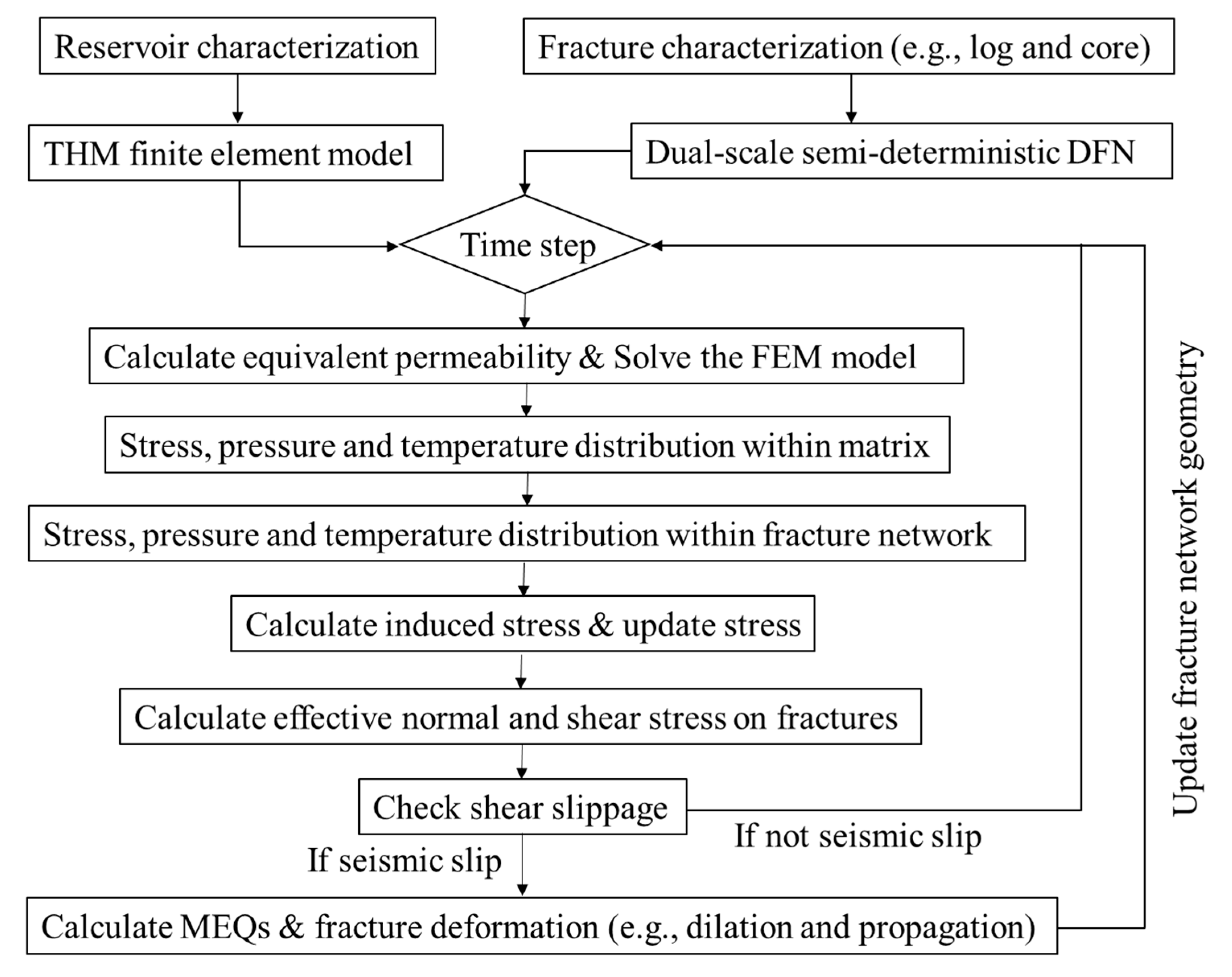
Appendix C. Model Verification


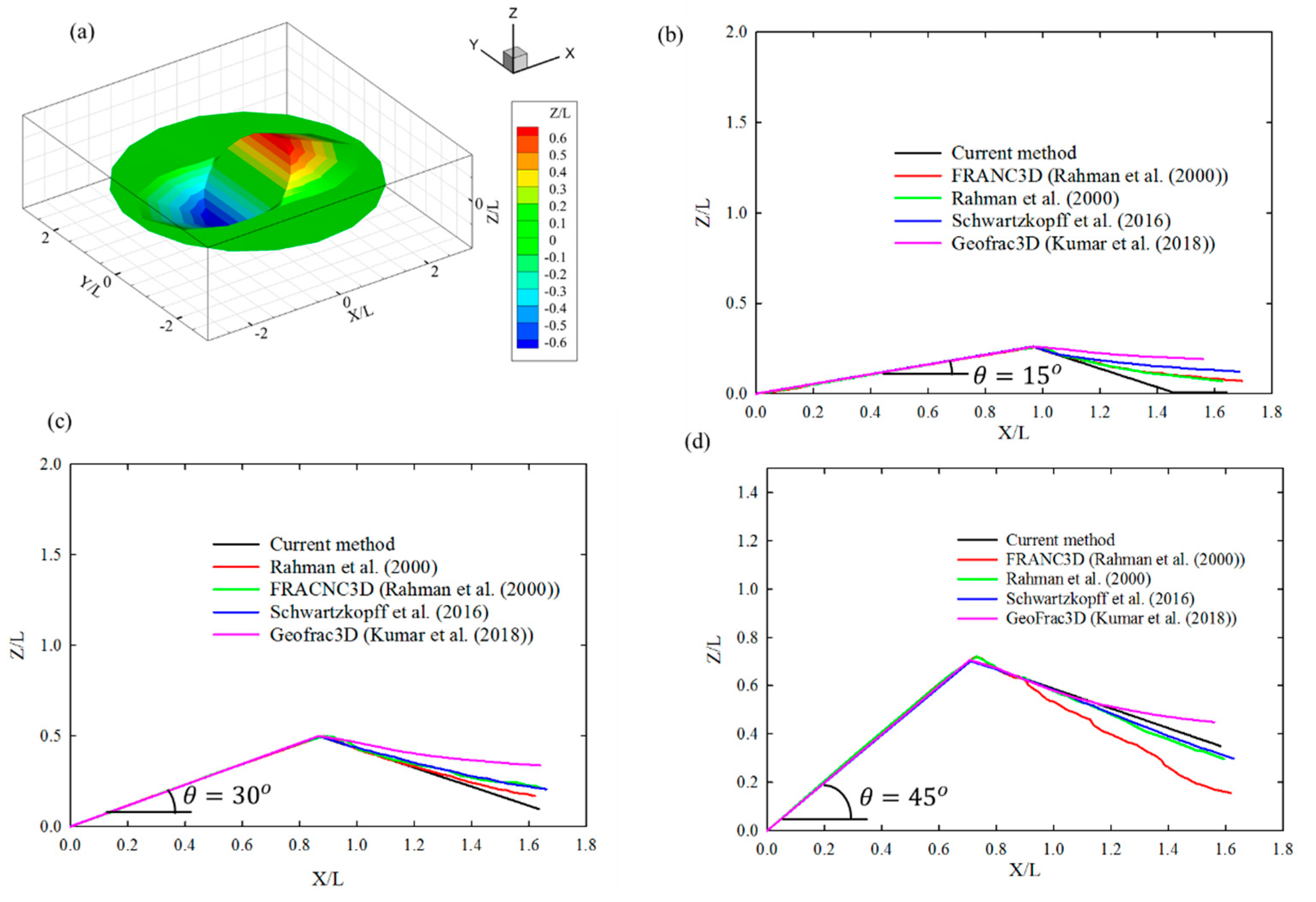
References
- Oldenburg, C.M.; Dobson, P.F.; Wu, Y.; Cook, P.J.; Kneafsey, T.J.; Nakagawa, S.; Ulrich, C.; Siler, D.L.; Guglielmi, Y.; Ajo-Franklin, J.B.; et al. Intermediate-Scale Hydraulic Fracturing in a Deep Mine—kISMET Project Summary 2016; Lawrence Berkeley National Lab. (LBNL): Berkeley, CA, USA, 2016. [Google Scholar]
- EGS Collab Team. Geothermal Data Repository. 2020. Available online: https://gdr.openei.org/home (accessed on 15 November 2020).
- Caddey, S.W.; Bachman, R.L.; Campbell, T.J.; Reid, R.R.; Otto, R.P. The Homestake Gold Mine, an Early Proterozoic Iron-Formation-Hosted Gold Deposit, Lawrence County, South Dakota; US Geological Survey; US Department of the Interior: Washington, DC, USA, 1992.
- Schwering, P.C.; Doe, T.W.; Roggenthen, W.M.; Neupane, G.H.; Johnston, H.; Dobson, P.F.; Ulrich, C.; Singh, A.; Uzunlar, N. Deterministic discrete fracture network (DFN) model for the EGS collab project on the 4850 level of the Sanford Underground Research Facility (SURF). In Proceedings of the 54th U.S. Rock Mechanics/Geomechanics Symposium, Golden, CO, USA, 28 June–1 July 2020; American Rock Mechanics Association: Alexandria, VA, USA, 2020; p. 9. [Google Scholar]
- Kneafsey, T.J.; Dobson, P.F.; Ajo-Franklin, J.B.; Guglielmi, Y.; Valladao, C.A.; Blankenship, D.A.; Schwering, P.C.; Knox, H.A.; White, M.D.; Johnston, T.C.; et al. EGS collab project: Status, tests, and data. In Proceedings of the 53rd U.S. Rock Mechanics/Geomechanics Symposium, American Rock Mechanics Association, New York, NY, USA, 23–26 June 2019; p. 19. [Google Scholar]
- Ulrich, C.; Dobson, P.F.; Kneafsey, T.J.; Roggenthen, W.M.; Uzunlar, N.; Doe, T.W.; Neupane, G.; Podgorney, R.; Schwering, P.; Frash, L.; et al. The distribution, orientation, and characteristics of natural fractures for experiment 1 of the EGS collab project, Sanford Underground Research Facility. In Proceedings of the 52nd U.S. Rock Mechanics/Geomechanics Symposium, American Rock Mechanics Association, Seattle, WA, USA, 17–20 June 2018; p. 8. [Google Scholar]
- Kneafsey, T.J.; Dobson, P.F.; Ajo-Franklin, J.B.; Valladao, C.; Blankenship, D.A.; Knox, H.A.; Schwering, P.; Morris, J.P.; Smith, M.; White, M.D.; et al. The EGS collab project: Stimulation and simulation. In Proceedings of the 52nd U.S. Rock Mechanics/Geomechanics Symposium, American Rock Mechanics Association, Seattle, WA, USA, 17–20 June 2018; p. 10. [Google Scholar]
- Kneafsey, T.J.; Dobson, P.F.; Blankenship, D.A.; Morris, J.P.; Knox, H.; Schwering, P.; White, M.; Doe, T.; Roggenthen, W.; Mattson, E.; et al. An overview of the EGS collab project: Field validation of coupled process modeling of fracturing and fluid flow at the Sanford Underground Research Facility, Lead, SD. In Proceedings of the 43rd Workshop on Geothermal Reservoir Engineering, Stanford, CA, USA, 12–14 February 2018. [Google Scholar]
- Willis-Richards, J.; Watanabe, K.; Takahashi, H. Progress toward a stochastic rock mechanics model of engineered geothermal systems. J. Geophys. Res. Space Phys. 1996, 101, 17481–17496. [Google Scholar] [CrossRef]
- Rahman, M.K.; Hossain, M.; Rahman, S.S. A shear-dilation-based model for evaluation of hydraulically stimulated naturally fractured reservoirs. Int. J. Numer. Anal. Methods Géoméch 2002, 26, 469–497. [Google Scholar] [CrossRef]
- Wang, X.; Ghassemi, A. A 3D thermal-poroelastic model for naturally fractured geothermal reservoir stimulation. In Proceedings of the 46th US Rock Mechanics and Geomechanics Symposium, Chicago, IL, USA, 24–27 June 2012. [Google Scholar]
- Lu, J.; Ghassemi, A. Coupled thermo-hydro-mechanical-seismic modeling of fractured reservoir stimulation with application to EGS collab. In Proceedings of the 44th Workshop on Geothermal Reservoir Engineering, Stanford, CA, USA, 10–12 February 2019. [Google Scholar]
- Cheng, Q.; Wang, X.; Ghassemi, A. Numerical simulation of reservoir stimulation with reference to the Newberry EGS. Geothermics 2019, 77, 327–343. [Google Scholar] [CrossRef]
- Hooker, J.N.; Laubach, S.E.; Marrett, R. A universal power-law scaling exponent for fracture apertures in sandstones. GSA Bull. 2014, 126, 1340–1362. [Google Scholar] [CrossRef]
- Long, J.C.S.; Remer, J.S.; Wilson, C.R.; Witherspoon, P.A. Porous media equivalents for networks of discontinuous fractures. Water Resour. Res. 1982, 18, 645–658. [Google Scholar] [CrossRef]
- Dershowitz, W.S.; Einstein, H.H. Characterizing rock joint geometry with joint system models. Rock Mech. Rock Eng. 1988, 21, 21–51. [Google Scholar] [CrossRef]
- Anders, M.H.; Laubach, S.E.; Scholz, C.H. Microfractures: A review. J. Struct. Geol. 2014, 69, 377–394. [Google Scholar] [CrossRef]
- Mitchell, T.M.; Faulkner, D.R. The nature and origin of off-fault damage surrounding strike-slip fault zones with a wide range of displacements: A field study from the Atacama fault system, northern Chile. J. Struct. Geol. 2009, 31, 802–816. [Google Scholar] [CrossRef]
- Tuttle, O.F. Structural Petrology of Planes of Liquid Inclusions. J. Geol. 1949, 57, 331–356. [Google Scholar] [CrossRef]
- Wang, X.; Ghassemi, A. A threedimensional thermal-poroelastic model for natural fractured geothermal reservoir stimulation. GRC Trans. 2013, 37, 871–878. [Google Scholar]
- Patton, F.D. Multiple modes of shear failure in rock. In Proceedings of the 1st ISRM Congress, International Society for Rock Mechanics and Rock Engineering, Lisbon, Portugal, 25 September–1 October 1966; p. 5. [Google Scholar]
- Hicks, T.; Pine, R.; Willis-Richards, J.; Xu, S.; Jupe, A.; Rodrigues, N. A hydro-thermo-mechanical numerical model for HDR geothermal reservoir evaluation. Int. J. Rock Mech. Min. Sci. Géoméch Abstr. 1996, 33, 499–511. [Google Scholar] [CrossRef]
- Eshelby, J.D.; Peierls, R.E. The determination of the elastic field of an ellipsoidal inclusion, and related problems. Proc. R. Soc. Lond. Ser. A Math. Phys. Sci. 1957, 241, 376–396. [Google Scholar]
- Valko, P.; Economides, M.J. Hydraulic Fracture Mechanics; Wiley: Chichester, UK, 1995; Volume 28. [Google Scholar]
- Sneddon, I.N. The distribution of stress in the neighbourhood of a crack in an elastic solid. Proc. R. Soc. London. Ser. A Math. Phys. Sci. 2006, 187, 229–260. [Google Scholar] [CrossRef]
- Min, K.S.; Zhang, Z.; Ghassemi, A. Numerical analysis of multiple fracture propagation in heterogeneous rock. In Proceedings of the 44th U.S. Rock Mechanics Symposium and 5th U.S.-Canada Rock Mechanics Symposium, American Rock Mechanics Association, Salt Lake City, UT, USA, 27–30 June 2010; p. 10. [Google Scholar]
- Kamali, A.; Ghassemi, A. Analysis of injection-induced shear slip and fracture propagation in geothermal reservoir stimulation. Geothermics 2018, 76, 93–105. [Google Scholar] [CrossRef]
- Kumar, D.; Ghassemi, A. Three-Dimensional Poroelastic Modeling of Multiple Hydraulic Fracture Propagation from Horizontal Wells. Int. J. Rock Mech. Min. Sci. 2018, 105, 192–209. [Google Scholar] [CrossRef]
- Sesetty, V.; Ghassemi, A. Effect of rock anisotropy on wellbore stresses and hydraulic fracture propagation. Int. J. Rock Mech. Min. Sci. 2018, 112, 369–384. [Google Scholar] [CrossRef]
- Tezuka, K.; Tamagawa, T.; Watanabe, K. Numerical simulation of hydraulic shearing in fractured reservoir. In Proceedings of the World Geothermal Congress, Antalya, Turkey, 24–29 April 2005. [Google Scholar]
- Ye, Z.; Ghassemi, A. Injection-Induced Shear Slip and Permeability Enhancement in Granite Fractures. J. Geophys. Res. Solid Earth 2018, 123, 9009–9032. [Google Scholar] [CrossRef]
- Ye, Z.; Ghassemi, A.; Kneafsey, T. Deformation, failure and permeability evolution of sealed fractures in EGS collab poorman schist. In Proceedings of the 45th Workshop on Geothermal Reservoir Engineering, Stanford, CA, USA, 10–12 February 2020. [Google Scholar]
- Ye, Z.; Ghassemi, A. Injection-Induced Propagation and Coalescence of Preexisting Fractures in Granite Under Triaxial Stress. J. Geophys. Res. Solid Earth 2019, 124, 7806–7821. [Google Scholar] [CrossRef]
- Kamali, A.; Ghassemi, A. On the Role of Poroelasticity in the Propagation Mode of Natural Fractures in Reservoir Rocks. Rock Mech. Rock Eng. 2020, 53, 2419–2438. [Google Scholar] [CrossRef]
- Masouleh, S.F.; Kumar, D.; Ghassemi, A. Three-Dimensional Geomechanical Modeling and Analysis of Refracturing and “Frac-Hits” in Unconventional Reservoirs. Energies 2020, 13, 5352. [Google Scholar] [CrossRef]
- Rahman, M.K.; Hossain, M.M.; Rahman, S.S. An analytical method for mixed-mode propagation of pressurized frac-tures in remotely compressed rocks. Int. J. Fract. 2000, 103, 243–258. [Google Scholar] [CrossRef]
- Schwartzkopff, A.K.; Xu, C.; Melkoumian, N.S. Approximation of mixed mode propagation for an internally pressurized circular crack. Eng. Fract. Mech. 2016, 166, 218–233. [Google Scholar] [CrossRef]
- Lu, J.; Ghassemi, A. Semi analytical 3D modeling of fracture propagation in a fractured rock. In Reservoir Geomechanics & Seismicity Research Group Internal Report; Reservoir Geomechanics and Seismicity Research Group, The University of Oklahoma: Norman, OK, USA, 2019. [Google Scholar]
- Hazzard, J.; Young, R.P. Dynamic modelling of induced seismicity. Int. J. Rock Mech. Min. Sci. 2004, 41, 1365–1376. [Google Scholar] [CrossRef]
- Safari, R.; Ghassemi, A. Three-Dimensional poroelastic modeling of injection induced permeability enhancement and mi-cro-seismicity. Int. J. Rock Mech. Min. Sci. 2016, 84, 47–58. [Google Scholar] [CrossRef]
- Baisch, S.; Vörös, R.; Rothert, E.; Stang, H.; Jung, R.; Schellschmidt, R. A numerical model for fluid injection induced seismicity at Soultz-sous-Forêts. Int. J. Rock Mech. Min. Sci. 2010, 47, 405–413. [Google Scholar] [CrossRef]
- Ye, Z.; Ghassemi, A. Investigation of micro-seismicity and permeability evolution in shale fractures during stimulation. In Proceedings of the 7th Unconventional Resources Technology Conference, American Association of Petroleum Geologists AAPG/Datapages, Denver, CO, USA, 22–24 July 2019; p. 11. [Google Scholar]
- Scotti, O.; Cornet, F.H. In-situ stress fields and focal mechanism solutions in central France. Geophys. Res. Lett. 1994, 21, 2345–2348. [Google Scholar] [CrossRef]
- Amann, F.; Gischig, V.; Evans, K.; Doetsch, J.; Jalali, M.R.; Valley, B.; Krietsch, H.; Dutler, N.; Villiger, L.; Brixel, B.; et al. The seismo-hydromechanical behavior during deep geothermal reservoir stimulations: Open questions tackled in a decameter-scale in situ stimulation experiment. Solid Earth 2018, 9, 115–137. [Google Scholar] [CrossRef]
- Scholz, C.H. The Mechanics of Earthquakes and Faulting, 3rd ed.; Cambridge University Press: Cambridge, UK, 2019. [Google Scholar]
- Marone, C. The spectrum of fault slip modes from elastodynamic rupture to slow earthquakes. In Mechanics of Earthquake Faulting; IOS Press: Amsterdam, The Netherlands; pp. 81–94. [CrossRef]
- Im, K.; Marone, C.; Elsworth, D. The transition from steady frictional sliding to inertia-dominated instability with rate and state friction. J. Mech. Phys. Solids 2019, 122, 116–125. [Google Scholar] [CrossRef]
- Gu, J.-C.; Rice, J.R.; Ruina, A.L.; Tse, S.T. Slip motion and stability of a single degree of freedom elastic system with rate and state dependent friction. J. Mech. Phys. Solids 1984, 32, 167–196. [Google Scholar] [CrossRef]
- Dobroskok, A.; Ghassemi, A. Deformation and stability of a discontinuity in a geothermal system. Trans. Geotherm. Resour. Counc. 2005, 29, 349–352. [Google Scholar]
- Rashidian, S.; Chang, L.C. Peak shear displacement of rock fractures. In Proceedings of the 46th U.S. Rock Mechanics/Geomechanics Symposium, American Rock Mechanics Association, Chicago, IL, USA, 24–27 June 2012. [Google Scholar]
- Asadollahi, P.; Invernizzi, M.C.A.; Addotto, S.; Tonon, F. Experimental Validation of Modified Barton’s Model for Rock Fractures. Rock Mech. Rock Eng. 2010, 43, 597–613. [Google Scholar] [CrossRef]
- Hanks, T.C.; Kanamori, H. A moment magnitude scale. J. Geophys. Res. Space Phys. 1979, 84, 2348–2350. [Google Scholar] [CrossRef]
- McGarr, A.; Spottiswoode, S.M.; Gay, N.C.; Ortlepp, W.D. Observations relevant to seismic driving stress, stress drop, and efficiency. J. Geophys. Res. Space Phys. 1979, 84, 2251. [Google Scholar] [CrossRef]
- Kneafsey, T.J.; Blankenship, D.; Dobson, P.F.; Morris, J.P.; White, M.D.; Fu, P.; Schwering, P.C.; Ajo-Franklin, J.B.; Huang, L.; Schoenball, M.; et al. The EGS collab project: Learnings from Experiment 1. In Proceedings of the 45th Workshop on Geothermal Reservoir Engineering, Stanford, CA, USA, 10–12 February 2020. [Google Scholar]
- Makedonska, N.; Jafarov, E.; Doe, T.; Schwering, P.; Neupane, G.; EGS Collab Team. Simulation of injected flow pathways in geothermal fractured reservoir using discrete fracture network model. In Proceedings of the 45th Workshop on Geothermal Reservoir Engineering, Stanford, CA, USA, 10–12 February 2020. [Google Scholar]
- Ye, Z.; Ghassemi, A.; Kneafsey, T. Deformation, failure and permeability evolution of sealed fractures in EGS collab poorman schist. In Proceedings of the 54th U.S. Rock Mechanics/Geomechanics Symposium, Golden, CO, USA, 28 June–1 July 2020. [Google Scholar]
- Ye, Z.; Ghassemi, A. Failure Behavior of the Poorman Schist and Its Fractures from the COLLAB Simulation Site. In Proceedings of the 44rd Workshop on Geothermal Reservoir Engineering, Stanford, CA, USA, 10–12 February 2020. [Google Scholar]
- Neupane, G.H.; Podgorney, R.K.; Huang, H.; Mattson, E.D.; Kneafsey, T.J.; Dobson, P.F.; Schoenball, M.; Ajo-Franklin, J.B.; Ulrich, C.; Schwering, P.C.; et al. EGS Collab Earth Modeling: Integrated 3D Model of the Testbed. In GRC Transactions; Geothermal Resources Council: San Diego, CA, USA, 2019. [Google Scholar]
- Ghassemi, A.; Zhang, Q. Porothermoelastic Analysis of the Response of a Stationary Crack Using the Displacement Discontinuity Method. J. Eng. Mech. 2006, 132, 26–33. [Google Scholar] [CrossRef]
- McTigue, D.F. Thermoelastic response of fluid-saturated porous rock. J. Geophys. Res. Space Phys. 1986, 91, 9533–9542. [Google Scholar] [CrossRef]
- Zhou, X.; Ghassemi, A. Finite element analysis of coupled chemo-poro-thermo-mechanical effects around a wellbore in swelling shale. Int. J. Rock Mech. Min. Sci. 2009, 46, 769–778. [Google Scholar] [CrossRef]
- Phan, A.-V.; Napier, J.A.L.; Gray, L.; Kaplan, T. Symmetric-Galerkin BEM simulation of fracture with frictional contact. Int. J. Numer. Methods Eng. 2003, 57, 835–851. [Google Scholar] [CrossRef]
- Warpinski, N.R.; Wolhart, S.L.; Wright, C.A. Analysis and Prediction of Microseismicity Induced by Hydraulic Frac-turing. SPE J. 2004, 9, 24–33. [Google Scholar] [CrossRef]

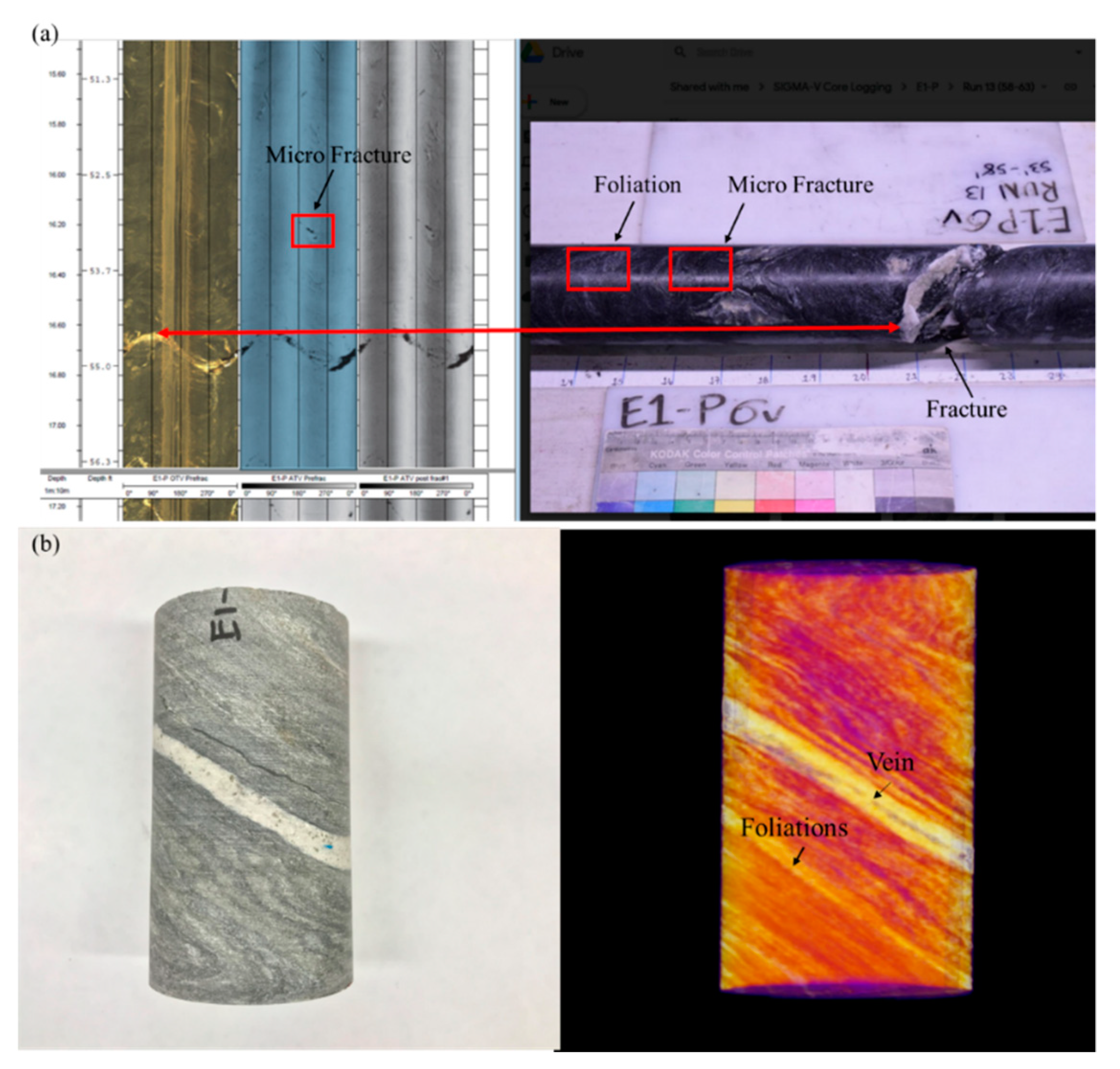
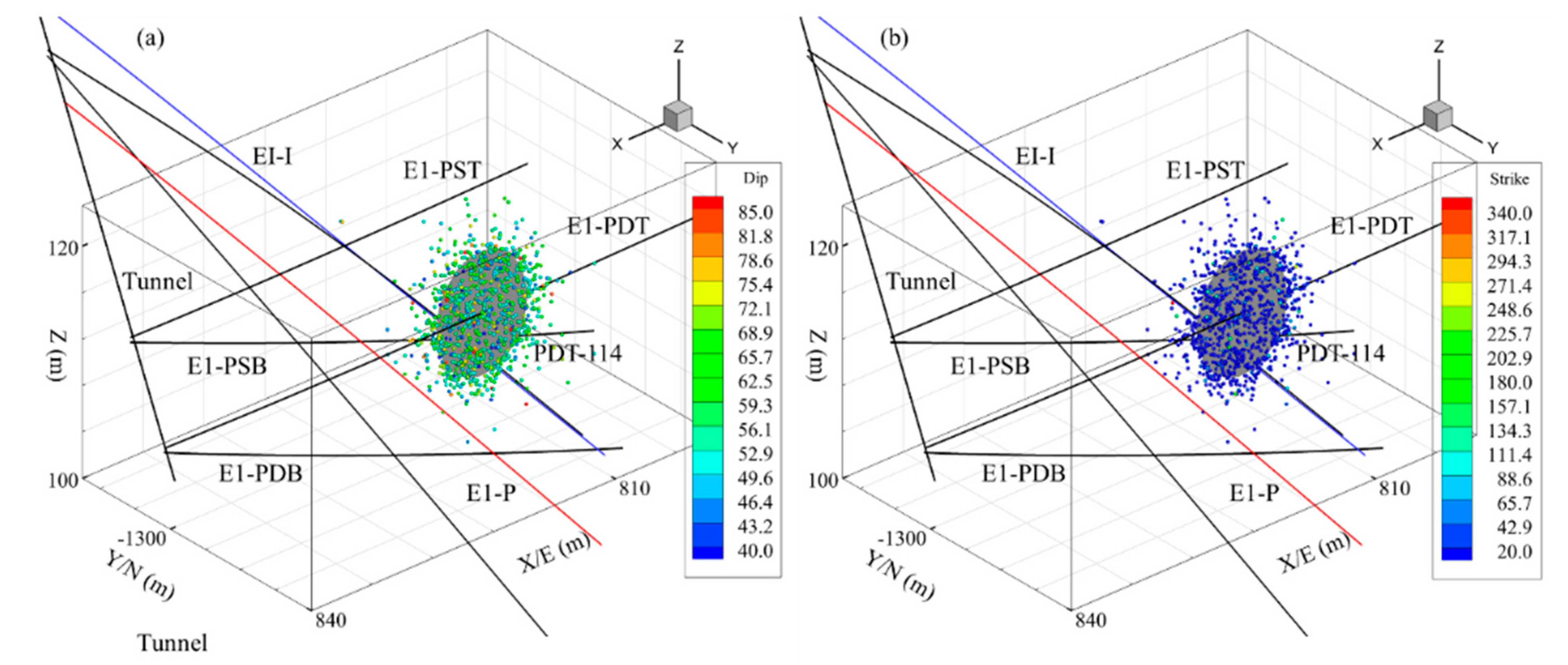
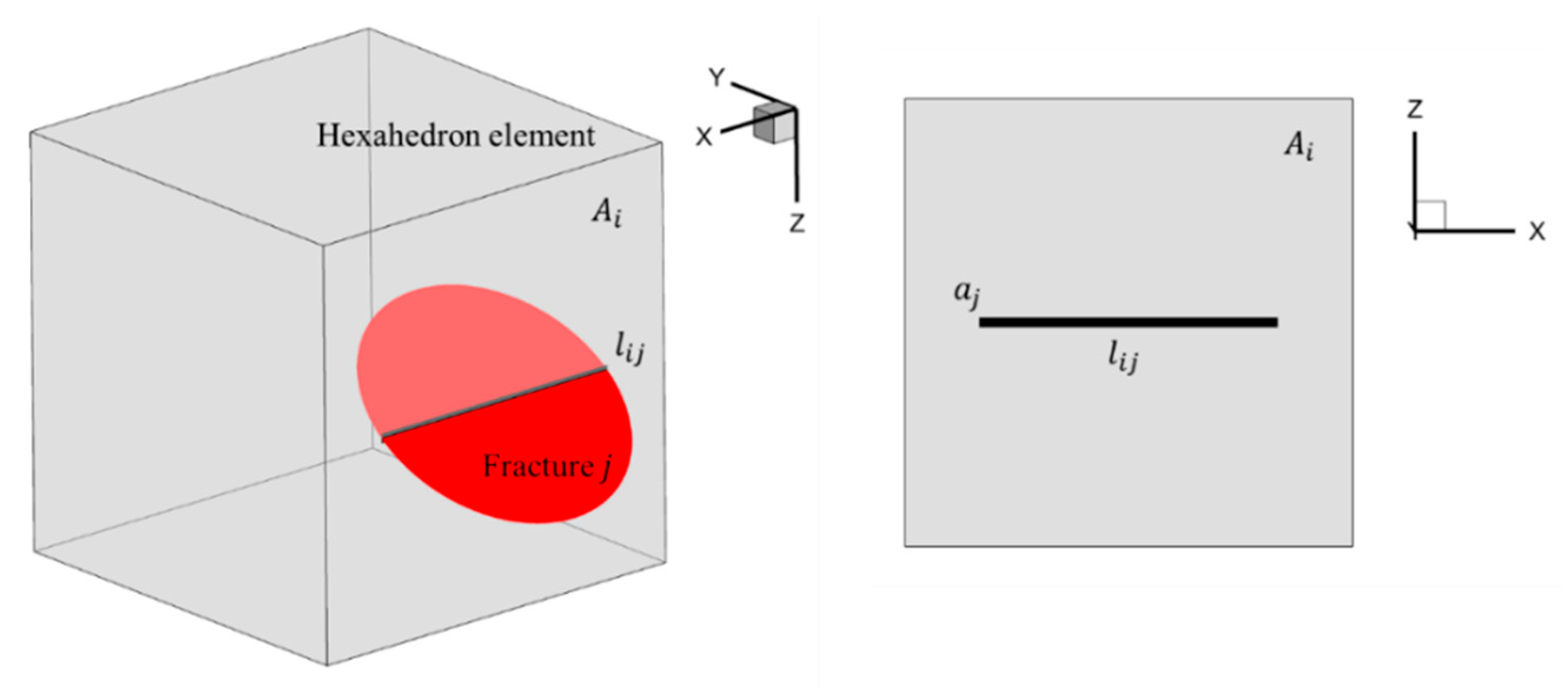


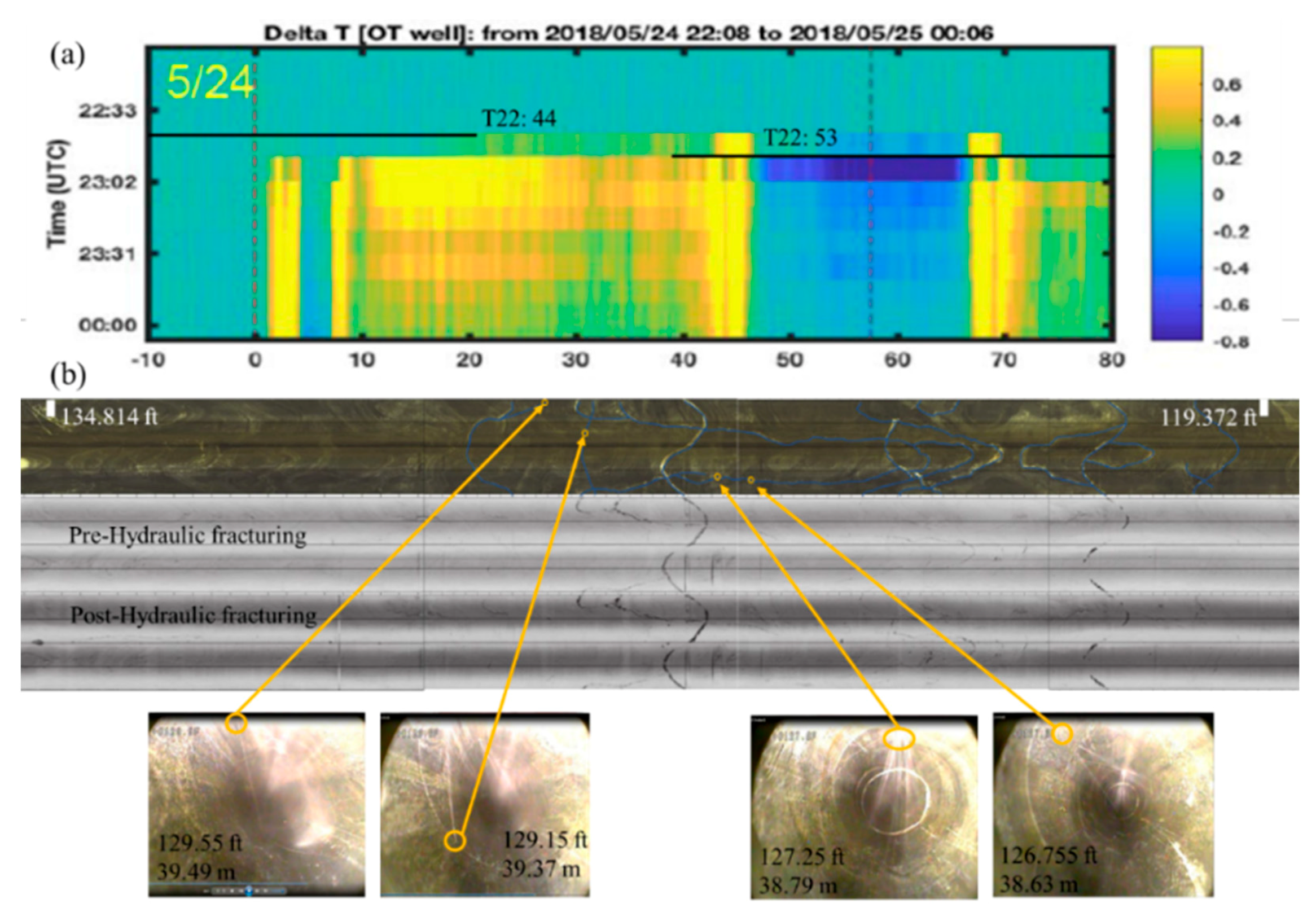
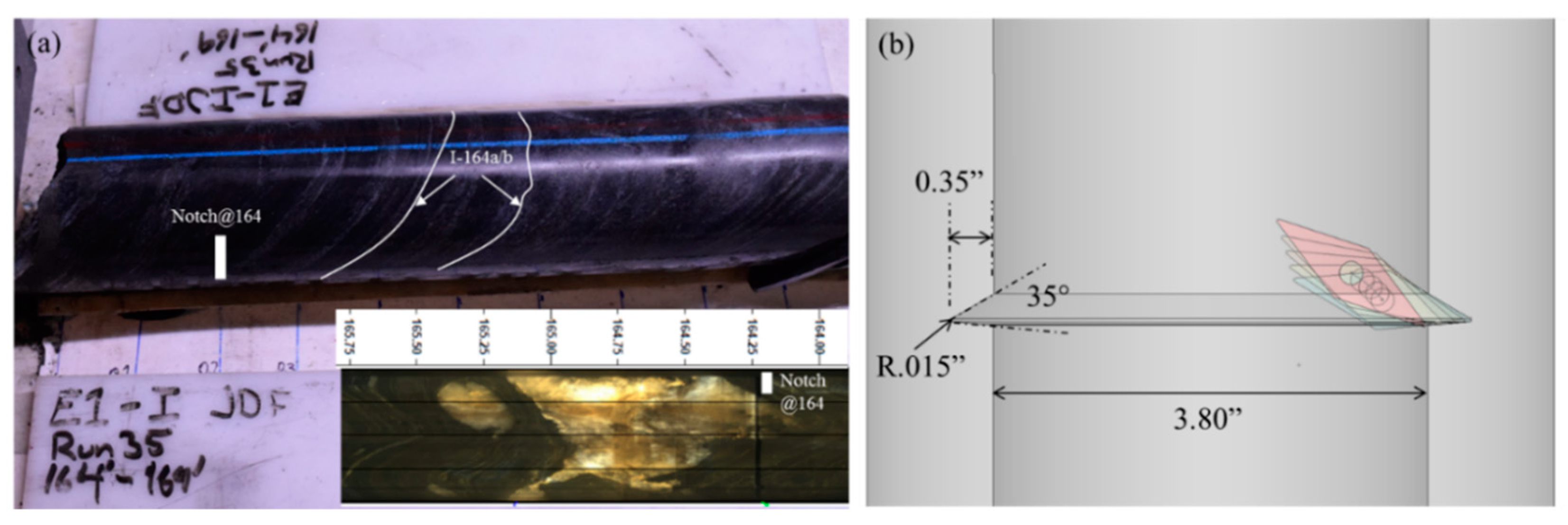

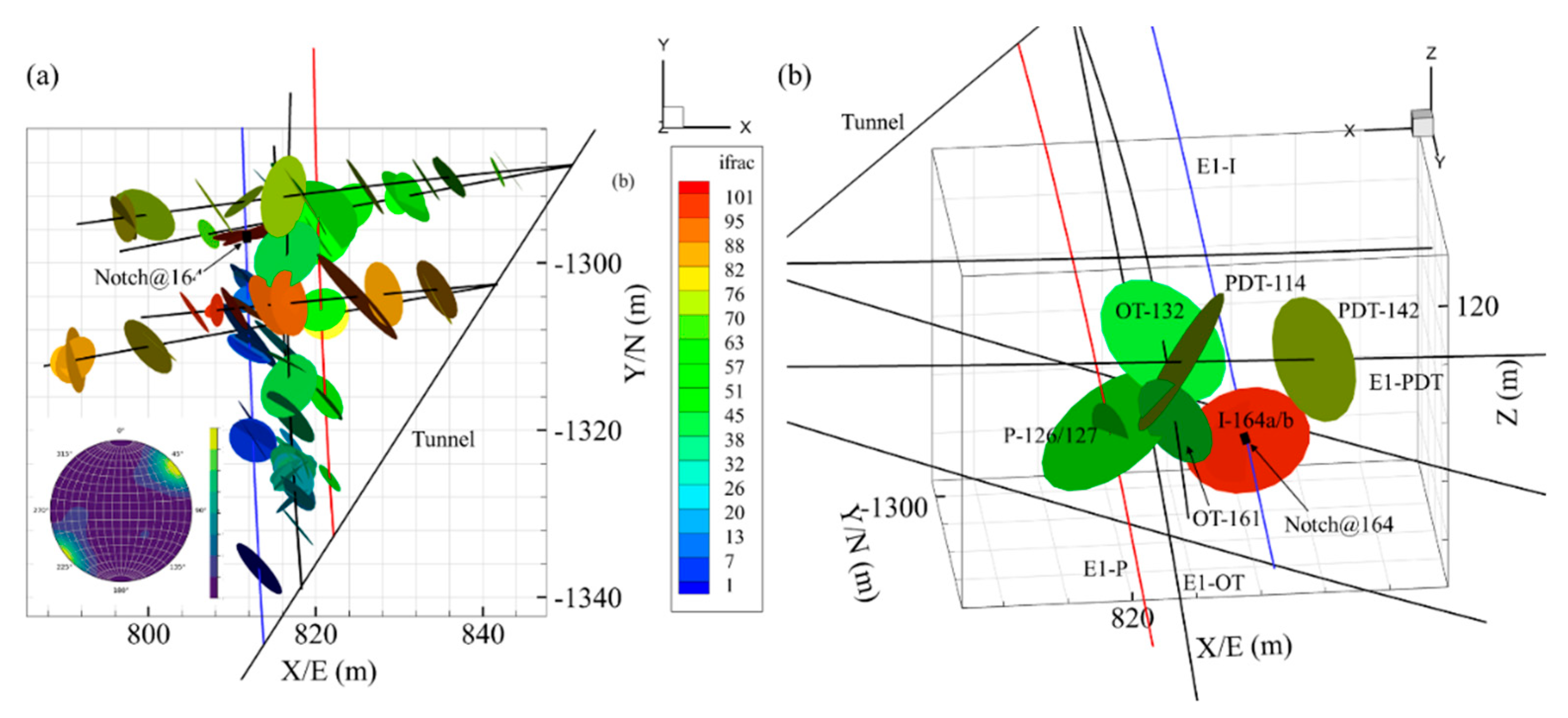

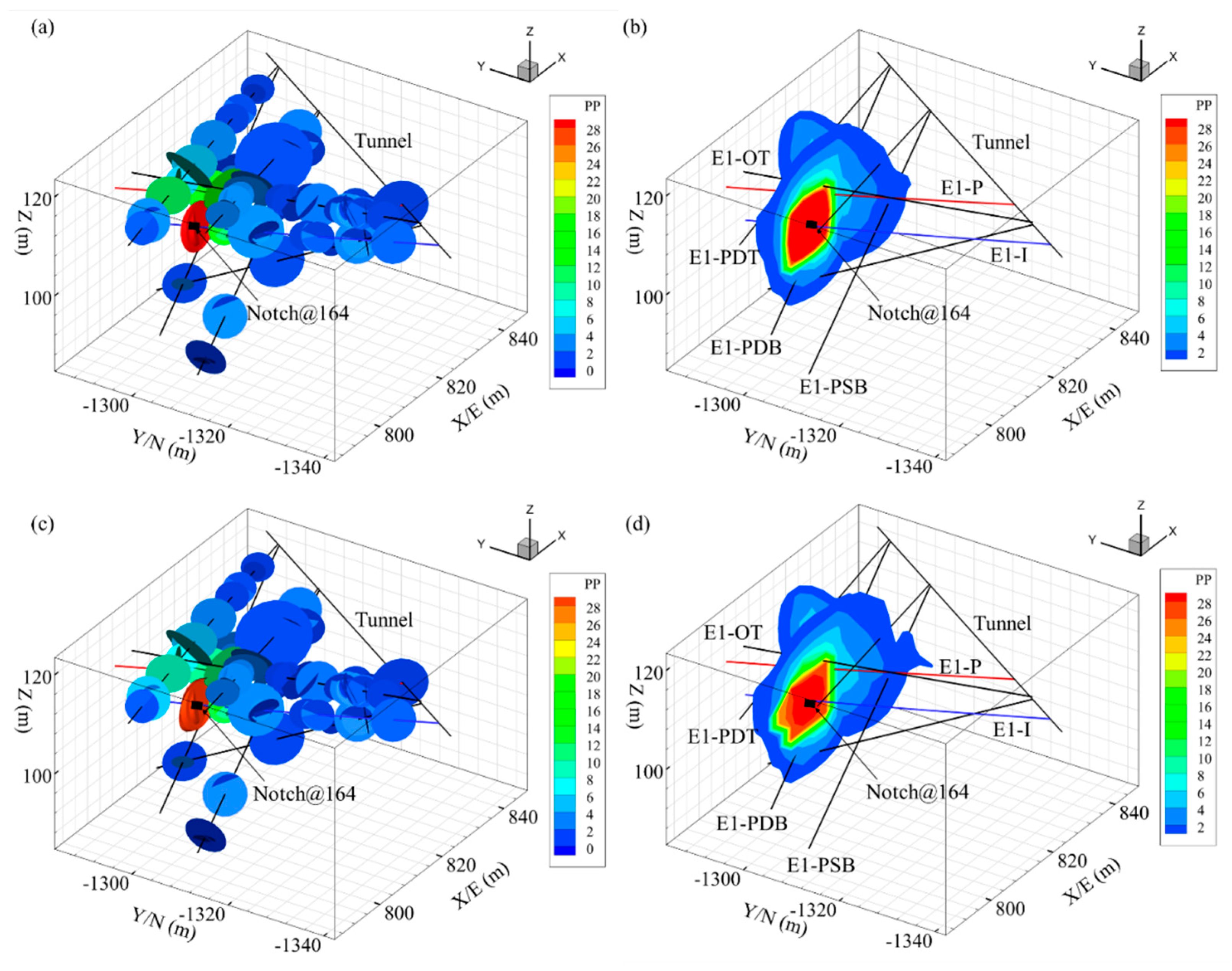

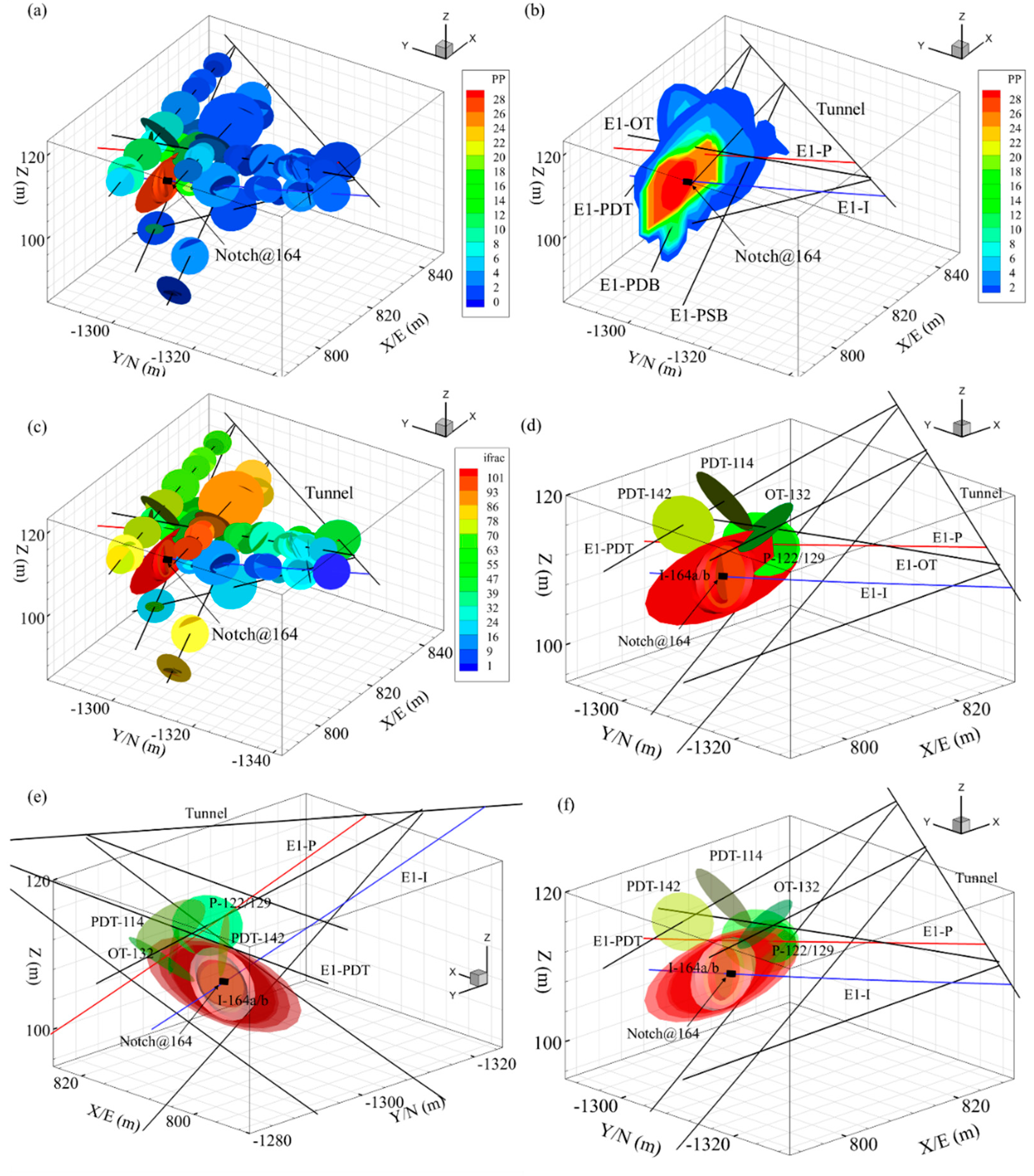

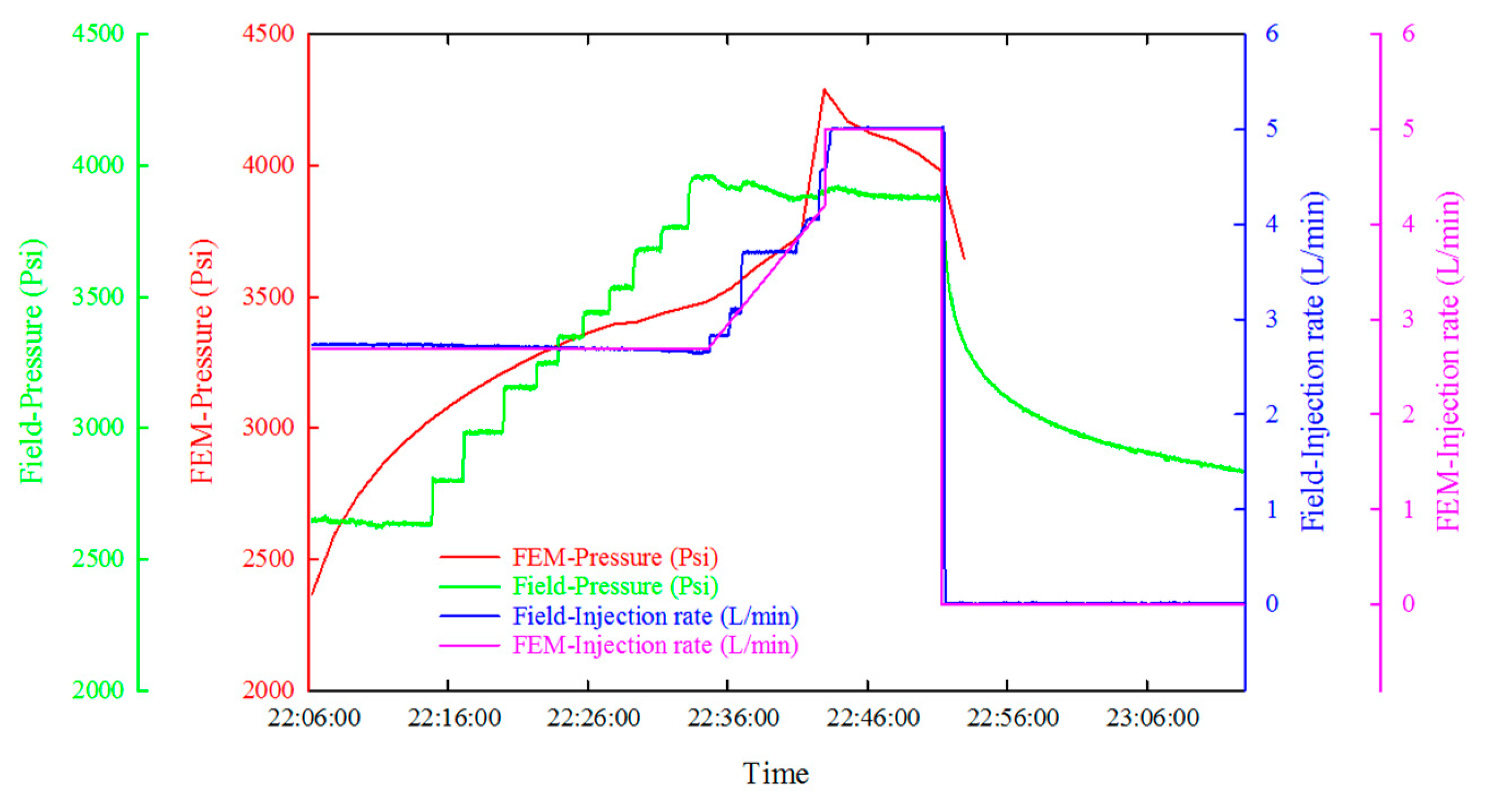

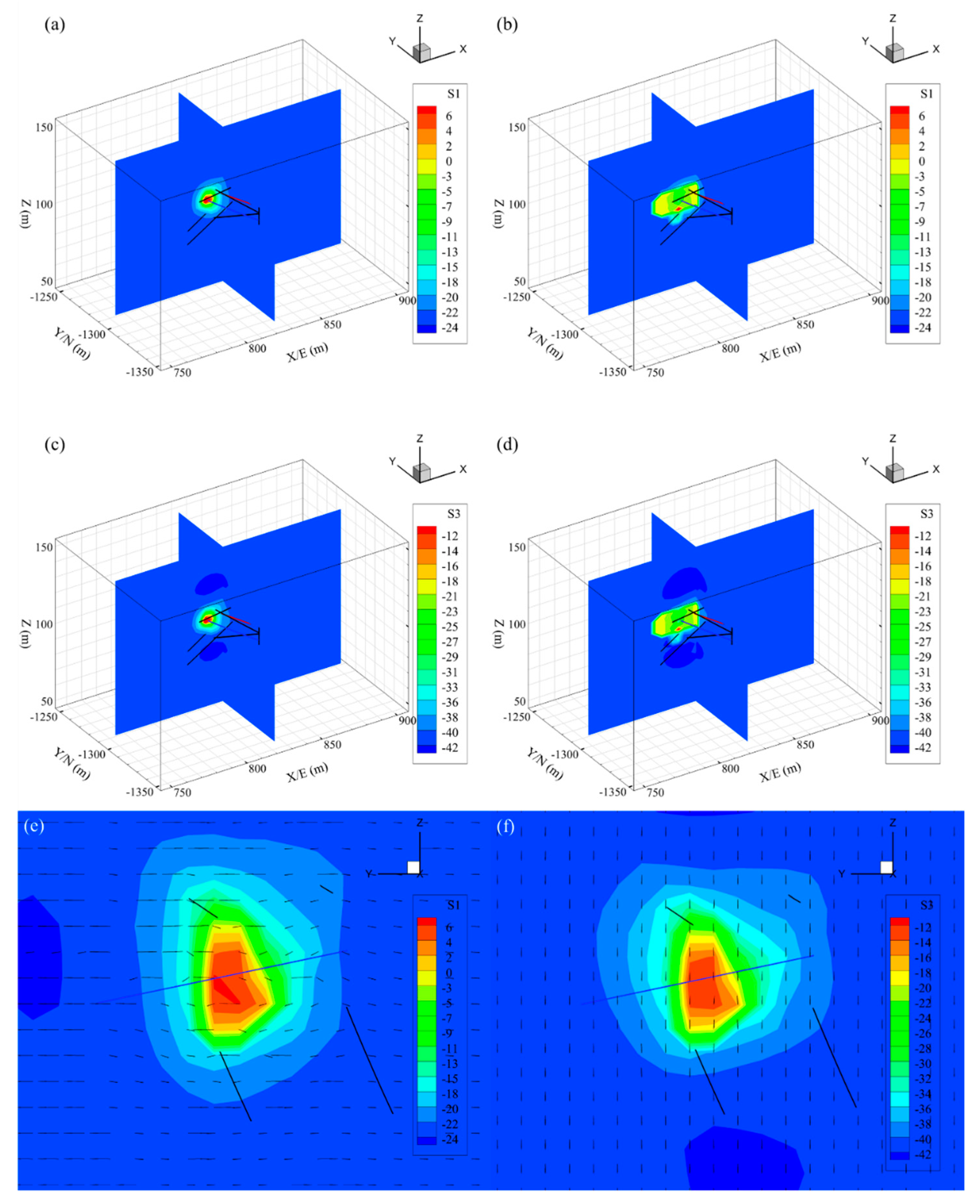
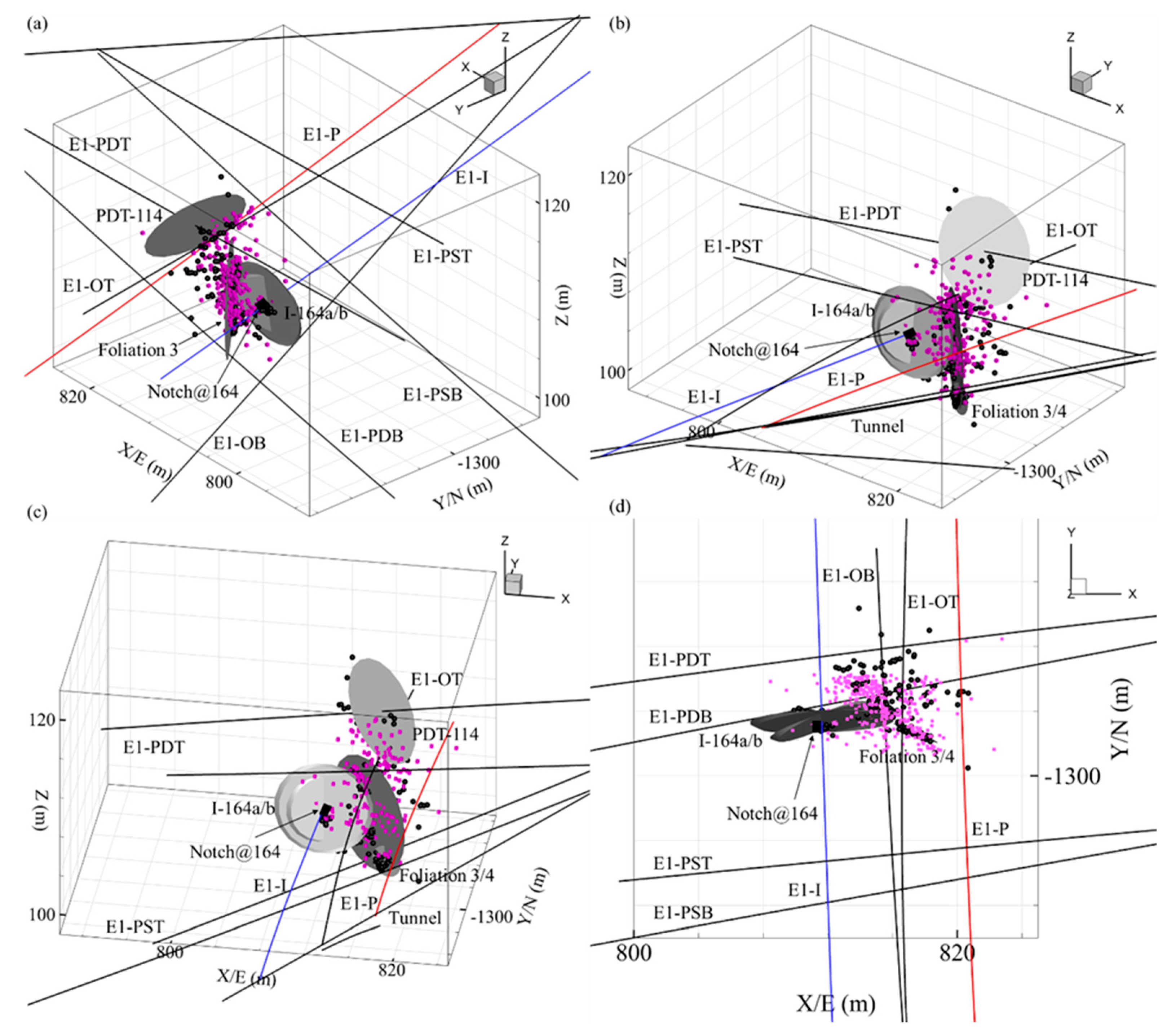
| Parameter Value | Values | Source/Comments |
|---|---|---|
| Young’s Modulus (Lognormal distribution) | 71 | [1] |
| Drained Poisson’s Ratio | 0.22 | [1] |
| Undrained Drained Poisson’s Ratio | 0.46 | Assumed |
| Biot’s Coefficient | 0.52 | Assumed |
| Vertical stress | 41.8 | [1] |
| Maximum horizontal stress | 35.5 | [1] |
| Minimum Horizontal stress | 21.7 | [1] |
| Initial pore pressure | 0.0 | [2] |
| Matrix Permeability | 0.05 | [2] |
| Mode I fracture toughness | [1] |
| Parameter Value | Values | Source/Comments |
|---|---|---|
| Density of micro-fractures | Assumed | |
| a | 2.4 × 10−2 | Cumulative power law distribution for micro-fracture radius: . F is the fracture cumulative frequency and is the fracture radius (mm). [14] |
| b | 0.1 | |
| >30 [mm] | The minimum radius of effective micro-fracture. Assumed | |
| Dilation angle | 0.035 | Assumed |
| Fracture radius (Lognormal distribution) | Estimating from [1] | |
| Fracture asperity (Lognormal distribution) | Assumed | |
| Cohesive (Lognormal distribution) | Assumed | |
| Frictional angle (Lognormal distribution) | Assumed |
Publisher’s Note: MDPI stays neutral with regard to jurisdictional claims in published maps and institutional affiliations. |
© 2021 by the authors. Licensee MDPI, Basel, Switzerland. This article is an open access article distributed under the terms and conditions of the Creative Commons Attribution (CC BY) license (http://creativecommons.org/licenses/by/4.0/).
Share and Cite
Lu, J.; Ghassemi, A. Coupled Thermo–Hydro–Mechanical–Seismic Modeling of EGS Collab Experiment 1. Energies 2021, 14, 446. https://doi.org/10.3390/en14020446
Lu J, Ghassemi A. Coupled Thermo–Hydro–Mechanical–Seismic Modeling of EGS Collab Experiment 1. Energies. 2021; 14(2):446. https://doi.org/10.3390/en14020446
Chicago/Turabian StyleLu, Jianrong, and Ahmad Ghassemi. 2021. "Coupled Thermo–Hydro–Mechanical–Seismic Modeling of EGS Collab Experiment 1" Energies 14, no. 2: 446. https://doi.org/10.3390/en14020446
APA StyleLu, J., & Ghassemi, A. (2021). Coupled Thermo–Hydro–Mechanical–Seismic Modeling of EGS Collab Experiment 1. Energies, 14(2), 446. https://doi.org/10.3390/en14020446




